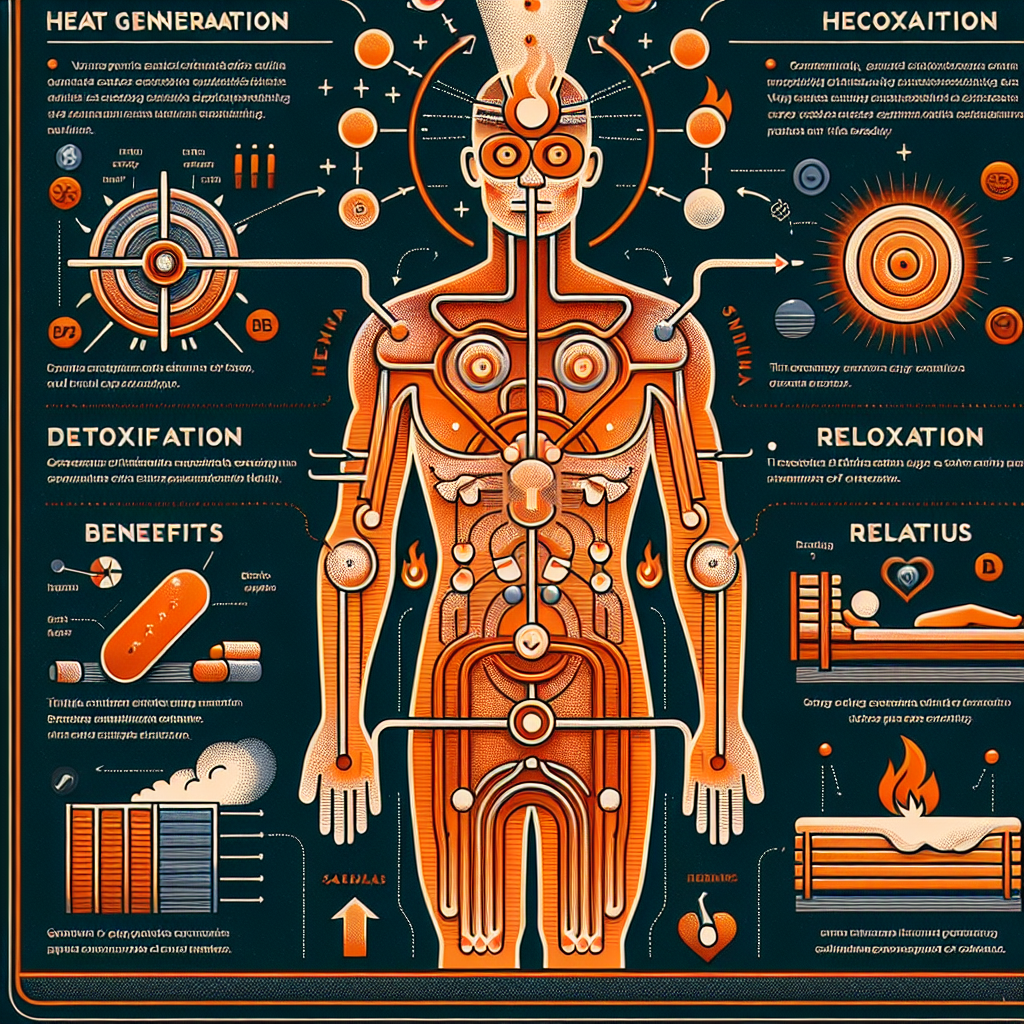So you’ve always been curious about saunas, huh? Well, get ready to uncover the secret behind melting away your stress and relaxing in these heated chambers. Saunas, a century-old tradition originating from Finland, have gained popularity worldwide for their numerous health benefits. From boosting circulation to detoxifying your body, saunas work by creating a dry heat environment that aids in producing a deep, cleansing sweat. But how exactly does this magical transformation from chilly to sweat-inducing warmth occur? Let’s take a closer look at the inner workings of saunas and discover the science behind this rejuvenating experience.

What is a sauna?
Definition
A sauna is a small room or enclosure that is designed to provide heat and steam. The goal of a sauna is to heat the body, induce sweating, and provide various health benefits. Saunas are popular for relaxation, improving circulation, and promoting overall well-being.
Types of saunas
There are several different types of saunas available, each with its own unique characteristics.
-
Traditional Saunas: These are the most common type of saunas and are typically heated with hot stones or wood-burning stoves. The heat is generated by a heater placed in the corner of the room, and the temperature can reach up to 190°F (90°C).
-
Infrared Saunas: Infrared saunas use infrared lamps to heat the body directly, rather than heating the air like traditional saunas. The temperature in an infrared sauna is typically lower, ranging from 120°F (48°C) to 150°F (66°C).
-
Steam rooms: Steam rooms are similar to saunas but use wet heat instead of dry heat. These rooms produce steam by pouring water onto heated rocks, generating a high humidity environment. Unlike in saunas, steam rooms have a lower temperature, usually ranging from 100°F (38°C) to 120°F (49°C).
History of saunas
Origins
The origins of saunas can be traced back thousands of years to the Scandinavian region. The Finnish people are particularly well-known for their sauna culture, which has deep historical roots. Saunas were initially used for bathing, as they provided a method of cleansing the body by inducing sweat. From there, saunas gradually evolved into spaces for relaxation, socializing, and promoting health benefits.
Traditional sauna cultures
Various traditional sauna cultures have developed around the world, each with its own unique practices and rituals. In Finland, saunas are an integral part of the culture, with sauna usage being a common daily activity. In Japan, saunas called “sento” are shared public bathhouses that serve as a place for relaxation and cleansing. Native American tribes also have their own traditional saunas, known as “sweat lodges,” which are used for spiritual and healing purposes.
Principles of heat transfer
Conduction
Conduction is the process of heat transfer through direct contact between objects. In a sauna, conduction occurs when the hot sauna benches or walls come in contact with your body, transferring heat to your skin.
Convection
Convection is the transfer of heat through the movement of warm air or liquid. In a sauna, convection occurs as the hot air circulates around the room, heating the objects and people inside.
Radiation
Radiation is the transfer of heat through electromagnetic waves. In a sauna, radiation occurs when the hot surfaces, such as the sauna heater or stones, emit infrared radiation that directly heats your body.
The sauna heating system
Heater types
Sauna heaters are the heart of the sauna system, responsible for generating the heat that warms the room. There are several types of sauna heaters available, including electric heaters, wood-burning heaters, and infrared heaters. Electric heaters are the most common and convenient option, as they can be easily controlled and provide consistent heat.
Electrical vs. wood-burning heaters
Electric heaters are popular for their ease of use and quick heat-up time. They are efficient, require minimal maintenance, and can be controlled with a thermostat. On the other hand, wood-burning heaters provide a more traditional sauna experience. They use wood as fuel, adding a natural ambience to the sauna, but require regular wood stocking and cleaning.
Sauna construction
Materials
Saunas can be constructed using a variety of materials, each with its own unique properties. Common materials used include wood, such as cedar or hemlock, which is known for its resistance to moisture and heat. Other materials, such as glass, metal, or tile, may also be used for specific design purposes.
Design considerations
When designing a sauna, several factors need to be considered. The size of the sauna should be determined based on the number of sauna users and available space. Proper insulation is crucial for energy efficiency and maintaining stable temperatures. Ventilation is also important to prevent excessive humidity buildup and ensure fresh air circulation.
Preparation for sauna use
Hygiene
Before entering a sauna, it is important to practice good hygiene. Take a shower to cleanse your body and remove any oils, lotions, or perfumes. This helps to maintain a clean and bacteria-free sauna environment. It is also recommended to sit on a towel or use a sauna seat cover to prevent direct contact between your body and the sauna benches.
Proper hydration
Proper hydration is vital when using a sauna. Drink plenty of water before, during, and after your sauna session to replenish the fluids lost through sweating. It is advisable to drink at least one or two glasses of water before entering the sauna and to have more available inside the sauna for hydration during the session.
Entering the sauna
Room temperature
The ideal temperature for a sauna varies depending on personal preference and the type of sauna. Traditional saunas typically range from 150°F (66°C) to 190°F (90°C), while infrared saunas and steam rooms have lower temperatures. Start with a lower temperature and gradually increase if desired.
Sauna etiquette
When entering a sauna, it is important to respect sauna etiquette to ensure a pleasant experience for everyone. Some common rules include keeping conversations at a low volume, avoiding excessive touching of sauna surfaces, and maintaining personal hygiene by sitting on a towel or using a sauna seat cover. It is also customary to leave the sauna clean and tidy for the next users.
Sauna experience
Sweating
Sweating is a natural response to the heat in a sauna and plays a vital role in the sauna experience. Sweating helps to regulate body temperature, remove toxins from the body, and promote relaxation. As you sit in the sauna, your body will start to perspire, leading to a feeling of cleansing and renewal.
Benefits
Saunas offer a wide range of benefits for both physical and mental health:
-
Detoxification: Sweating in a sauna helps to flush out toxins and impurities from the body, promoting detoxification and cleansing.
-
Improved circulation: The heat and steam in a sauna cause blood vessels to dilate, improving blood flow and circulation throughout the body.
-
Relaxation and stress relief: Saunas provide a tranquil environment that promotes relaxation, reduces stress, and helps to relieve tension.
-
Skin health: The combination of heat and sweat in a sauna can help to cleanse the skin, unclog pores, and promote a healthy complexion.
Risks
While sauna use is generally safe for most people, there are a few risks to be aware of:
-
Dehydration: Excessive sweating can lead to dehydration if proper hydration is not maintained. It is important to drink enough water before, during, and after a sauna session.
-
Overheating: Prolonged exposure to high temperatures can cause overheating, especially if you have underlying health conditions or do not listen to your body’s signals. It is important to monitor your comfort level and exit the sauna if you feel lightheaded or dizzy.
Health benefits of saunas
Detoxification
Saunas are known for their detoxifying effects on the body. Sweating helps to eliminate toxins through the skin and promote the elimination of waste products, such as heavy metals and chemicals, from the body. Regular sauna use can support the body’s natural detoxification processes.
Improved circulation
The heat and steam in a sauna cause blood vessels to expand, improving circulation and delivering more oxygen and nutrients to the body’s tissues. This increased blood flow can have numerous benefits, including improved cardiovascular health, reduced muscle soreness, and enhanced overall vitality.
Relaxation and stress relief
Saunas provide a peaceful and calming environment that promotes relaxation and helps to alleviate stress. The warmth and gentle heat of the sauna can help to soothe both the body and the mind, reducing tension, anxiety, and promoting a sense of well-being.
Skin health
The combination of heat and sweat in a sauna can have positive effects on the skin. Sweating helps to cleanse the pores, removing dirt, oil, and dead skin cells. This deep cleansing can improve the overall appearance and health of the skin, leaving it rejuvenated and glowing.
Sauna maintenance and safety
Cleaning
Regular cleaning is essential to maintain a clean and hygienic sauna environment. Wipe down the sauna benches, walls, and floors after each use to remove any sweat or dirt. Deep cleaning should be done periodically using sauna-specific cleaners that are safe for the materials used in the sauna construction.
Ventilation
Proper ventilation is important to ensure fresh air circulation and prevent excessive humidity buildup in the sauna. Good ventilation helps to maintain a comfortable and safe environment for sauna users. The sauna should have an vent or an open window to allow fresh air exchange and prevent a stagnant atmosphere.
Sauna safety guidelines
To ensure a safe sauna experience, it is important to follow these guidelines:
-
Limit sauna sessions to a recommended duration of 10 to 20 minutes, depending on personal tolerance and the type of sauna.
-
Listen to your body and exit the sauna if you feel lightheaded, dizzy, or experience any discomfort.
-
Avoid alcohol and drugs before or during sauna use, as they can impair judgment and lead to overheating.
-
Do not use saunas if you are pregnant, have certain medical conditions, or are under the influence of medication that may be affected by heat exposure. Consult with your healthcare provider before using a sauna if you have any concerns.
Remember, sauna usage should be a positive and enjoyable experience. By understanding the principles of heat transfer, practicing proper hygiene and hydration, and following safety guidelines, you can maximize the benefits and safely incorporate saunas into your wellness routine.

